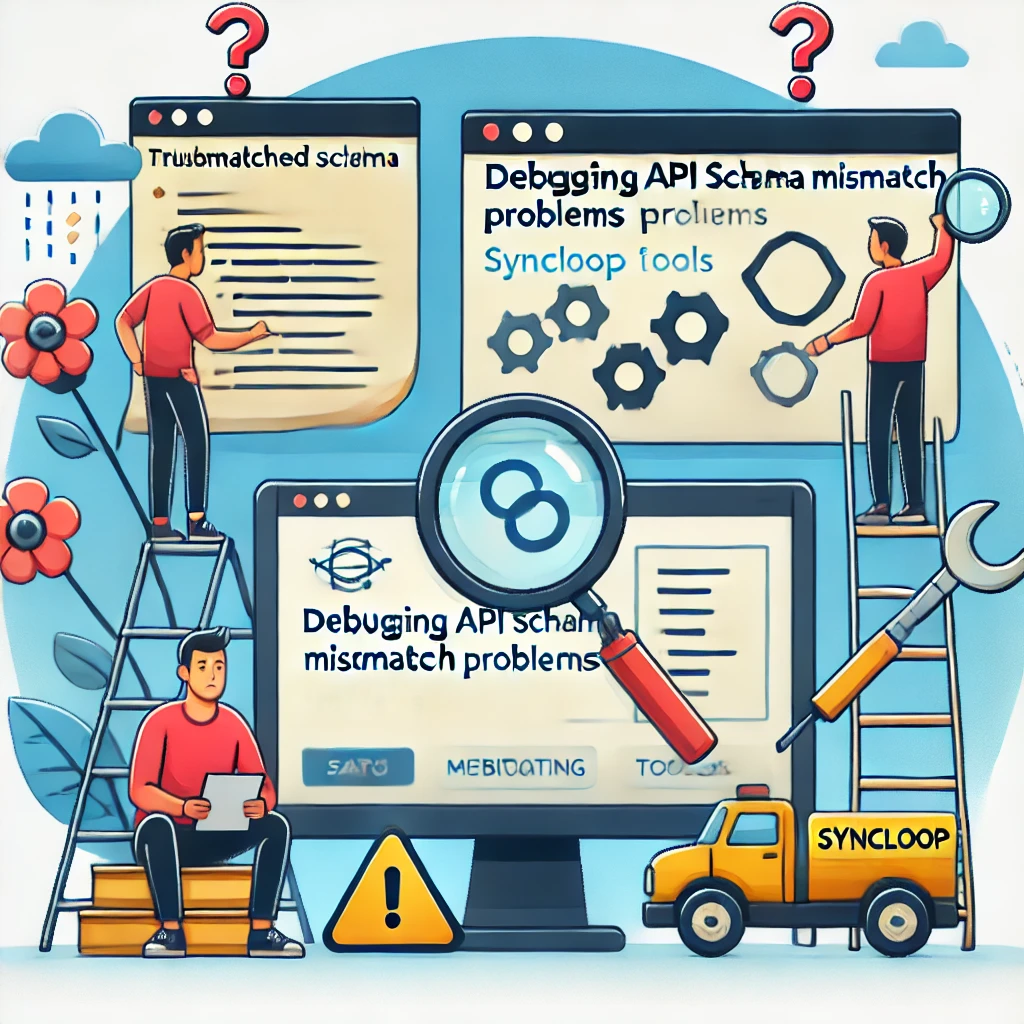Debugging API Schema Mismatch Problems with Syncloop Tools

Syncloop offers a suite of tools designed to simplify the debugging process for API schema mismatches. This blog explores common causes of schema mismatches, how Syncloop tools can address these issues, and best practices for ensuring consistent API schemas.
What is an API Schema Mismatch?
An API schema mismatch happens when the expected structure, data types, or fields in an API request or response differ from the actual implementation. This could involve:
- Missing Fields: Expected fields not present in the API response or request.
- Incorrect Data Types: Mismatches in the expected type, such as a string instead of an integer.
- Renamed or Deprecated Fields: Changes in field names or removal of fields causing integration errors.
- Nested Structure Errors: Issues in hierarchical or nested JSON structures.
Challenges in Debugging Schema Mismatches
Schema mismatches are particularly challenging due to:
- Complexity of APIs: Large APIs with numerous endpoints and nested structures.
- Dynamic Updates: Frequent updates to API schemas without adequate versioning.
- Lack of Documentation: Poorly documented APIs make it hard to identify expected schemas.
- Real-Time Failures: Detecting mismatches during runtime can disrupt critical operations.
How Syncloop Simplifies Schema Debugging
Syncloop provides powerful tools to detect and resolve API schema mismatches efficiently. Key features include:
- Schema Validation Syncloop validates API requests and responses against predefined schemas, highlighting inconsistencies.
- Dynamic Data Mapping Map and transform fields dynamically to align mismatched schemas without altering source data.
- Simulation Environment Test APIs in a controlled environment to detect schema-related issues before deployment.
- Detailed Error Logs Syncloop generates detailed logs pinpointing mismatched fields and data types for quicker debugging.
- Real-Time Monitoring Monitor live API traffic to detect and address schema mismatches in real time.
Steps to Debug API Schema Mismatches with Syncloop
Step 1: Identify Mismatched Endpoints
Use Syncloop’s monitoring tools to locate endpoints where schema mismatches occur. Focus on:
- High error rates.
- Unexpected responses during API calls.
- Failed integrations reported by downstream systems.
Step 2: Validate the Schema
Leverage Syncloop’s schema validation features to compare the actual response or request structure against the expected schema. Look for:
- Missing or extra fields.
- Incorrect data types.
- Structural inconsistencies in nested fields.
Step 3: Update or Map Fields
Use Syncloop’s dynamic data mapping tools to transform mismatched fields. For example:
- Add default values for missing fields.
- Convert data types (e.g., string to integer) to ensure compatibility.
- Rename fields to match consumer expectations.
Step 4: Test with Mock Data
Simulate API calls in Syncloop’s testing environment using mock data. This helps identify and resolve mismatches without impacting live systems.
Step 5: Implement Schema Updates
Update the API schema or notify the API provider about discrepancies. Syncloop supports version control, allowing smooth transitions between schema updates.
Step 6: Monitor and Iterate
Enable real-time monitoring to track schema consistency and ensure issues do not recur. Analyze logs periodically to identify potential mismatches proactively.
Best Practices for Avoiding Schema Mismatches
- Adopt Schema Versioning Use versioning to ensure backward compatibility and clear communication about schema updates.
- Document APIs Thoroughly Maintain detailed and up-to-date API documentation to guide consumers on schema structures.
- Enable Real-Time Alerts Configure alerts in Syncloop to detect mismatches as soon as they occur.
- Use Strict Validation Implement strict schema validation rules to enforce data consistency.
- Automate Testing Regularly test APIs using automated tools to identify schema-related issues before deployment.
Example Use Case: Debugging E-Commerce API Mismatches
An e-commerce platform integrates with a third-party shipping API. After an update to the shipping API, order tracking fails due to a schema mismatch. Syncloop simplifies the debugging process by:
- Validating Requests: Identifying that the order_id field is missing in the API response.
- Mapping Data: Adding a default value for order_id to ensure compatibility.
- Testing Integration: Simulating API calls to confirm the fix.
- Monitoring Performance: Tracking the endpoint in real time to ensure consistent operation.
Benefits of Debugging with Syncloop
- Faster Issue Resolution: Syncloop’s tools streamline the debugging process, reducing downtime.
- Improved Data Consistency: Dynamic data mapping ensures smooth integration despite mismatched schemas.
- Enhanced Collaboration: Clear logs and insights help teams collaborate effectively to resolve issues.
- Proactive Error Detection: Real-time monitoring identifies mismatches before they impact users.
The Future of API Schema Management
As APIs become increasingly dynamic, the need for automated schema validation and debugging tools will grow. Syncloop provides the tools enterprises need to adapt to changing schemas, ensuring smooth integrations and reliable API ecosystems.
Image Description
A conceptual graphic showing API schema validation using Syncloop, with mismatched fields highlighted and corrected in real time. The image illustrates dynamic data mapping and validation workflows.
Back to Blogs